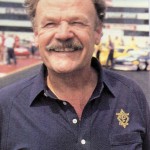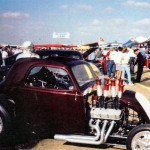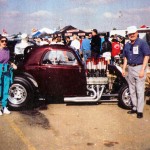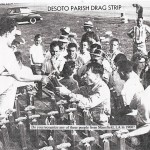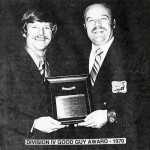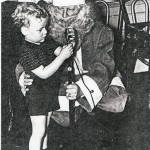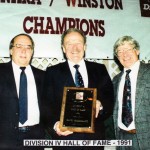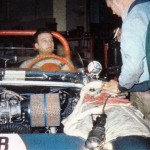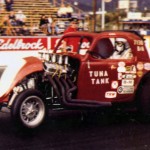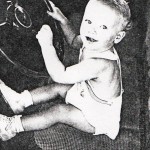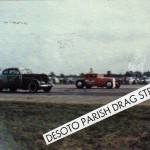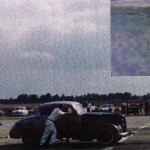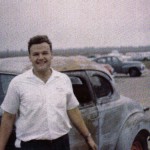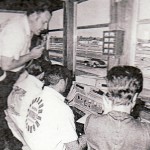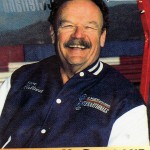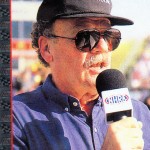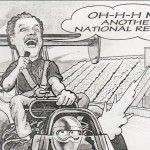Dave McClelland
Recently, the velvet-throated Dave McClelland was doing what he does best, emceeing an event. In a moment, though, he went from being the guy honoring people to the guy . . . being honored. “It was an absolute surprise to both my wife and myself . . .. When Susan Wade, the presenter, started off talking about an airport drag strip in Carlisle, Arkansas . . . I knew I was dead meat!Dave was at the Hilton Hotel in Ontario, California, for the 39th annual American Auto Racing Writers and Broadcasters’ All-America banquet when he was surprised to become the very first media person to get the Pioneer Award, presented to him for years of dedication to his art.”It was quite an honor . . . greatly and humbly appreciated,” continued Dave.
And this brief comment explains in large part why Dave McClelland has stood out from the herd all these years in a world of blinding speed and spectacular automobiles, hot rods, cruisers and dragsters — he’s a classy kind of guy you’d want to call friend . . . and over the years he has been friend to a vast range of men and women, including the real movers and shakers in the culture of cars and the sport of speed. And, in rubbing shoulders with great men and women, he not only helped elevate them, but he has elevated himself through hard work that generally meant holding down two jobs throughout his working life. In the process, Dave has won countless honors like that Pioneer Award.
In trying to come up with a list of honors he has achieved, Dave says, “Needless to say, there are a bunch.” Here goes on what he considers some of the most significant:
Car Craft Magazine Ollie Award . . . the Car Craft All Star Drag Racing team award for lifelong contributions to the sport of drag racing.
SEMA Hall of Fame . . . again, for long service and participation.
Founders Award . . . from The International Drag Racing Hall of Fame (Don Garlits’ Museum), for contributions over the years to drag racing.
There are a lot more, but this is as good a place as any to start telling Dave McClelland’s life story.
Dave, who is now 72 years old, says, “I really was interested in music and drama when I was in high school in Liberty, Missouri — so much so that I took some private singing lessons before going off to college where my intent was to become a football coach. I was going to minor in music. “I played ball in high school and in college, but it didn’t take me long to figure out that coaching really wasn’t what I had hoped. The school — Central Missouri State College in Warrensburg — offered an experimental course in radio and TV production in the first quarter of my second year.”Being active in drama and enjoying singing, I thought this should be a piece of cake! Well, they had no equipment — just a wire recorder where you could record your voice, a wooden tripod with a cardboard box on top to simulate a camera, and a workbook. That was it!”Even so, I quickly figured out that someone would actually pay me money to sit and talk — and I went home on break and told my folks I wanted to change majors and schools . . . and that’s what led me to Iowa State in Ames for their radio TV production education course.
At that time, 1955, Northwestern and Iowa State were the only two schools in the Midwest with respected radio-TV programs. “However, ISC was an engineering and agricultural college and required all sorts of science and math courses to graduate. I could have cared less about that and as a result . . . got a very, very intensive two years in radio and TV.”At the end of my junior year, the head of the radio-TV department called me in and told me they had nothing more to offer me, so it was time I got a job.”
Now, if you close your eyes, we’ll bet you can hear Dave McClelland’s clear, unhurried voice telling this story of his lifetime . . ..”That was the end of 1956, and I got a job as a studio cameraman at a TV station in Little Rock, Arkansas . . . and I started looking for work as an announcer. A few months later, I moved to a radio job in Shreveport, Louisiana . . . and my time there in radio-TV lasted till 1969 when I left to run Southland Dragway in Houma.”
But, how did a kid from Missouri become the man people referred to as The Voice of the NHRA? The great thing about Dave is that if you ask a question, he’ll take the time to answer you. And, here’s what he had to say about getting into the sport of drag racing, something that has now kept him busy all these years.
“I went to my first drag race in 1955, at the new track in Kansas City, Missouri, the city where I was born. Was just finishing high school in Liberty, Missouri, and the event was the kickoff of the new track — which hosted the NHRA Nationals in 1956. “This first event was one of the stops in 1955 of the original NHRA Drag Safari, a group that toured the country for three years, bringing drag racing to all parts of the U.S.”I was blown away by what I saw,” says Dave. “I had been attending oval track events for several years, but this was something totally unique . . . you could get close to the cars, the drivers, the action. What a far cry from being in the grandstand at a midget dirt track. Not that oval racing is bad, but drag racing is something I could see myself doing — and I did. Nothing spectacular . . . . just the everyday Joe driving his everyday car. But, it hooked me as evidenced by my career. I still enjoy it as much today as over 50 years ago. And, I still enjoy the oval racing as well. Just like it all!”
“Since 1959 — the year of my debut into the world of race announcing — I had traveled a dual path. My paying job was radio . . . and by then, primarily TV. I would announce races on the weekend just about anywhere that I was asked. Most were no-pay jobs . . . maybe expenses . . . and a very few that compensated the help. It was mostly an opportunity to be involved. Little did I realize at the time that I was laying the groundwork for what eventually became a career.
While in Shrevport in 1960, Dave got involved with the formation of a car club, the Ark-La-Tex Timing Association. I asked him about the goal of the group. His answer, “It was formed for the sole purpose of running drag races on an airport track in Mansfield, Louisiana. That was my first experience as manager of a track, and like the announcing jobs, was a great foundation for what lay in the future. We operated the track for only 1960 . . . . just as well . . . since 1961 was when I started my announcing career in earnest.
“By late 1968, after serving as a multi-faceted television announcer, host, newsman, sportscaster, weatherman, etc., I was promoted to Program Director of the station that I had joined some five years earlier. All the while, I had continued to develop and progress as a race announcer, not only on the local and divisional level, but I was doing all of NHRA’s national events as well. This provided me with tremendous exposure in the racing world.
“In 1969 I was approached by the principals at Southland Dragways, inquiring about possible interest in the General Manager’s position. The track had opened earlier in 1969 and is regarded by many as the Orange County International Raceway of the South. (Here is a link to a forum site, complete with lots of pictures, a large number of them Dave’s that not only describes other people’s reactions, but graphically shows the quality of the place: http://www.hotrodder.com/cgi-bin/dragstrips/YaBB.pl?num=1199391570).
“I moved my family from North Louisiana (Shreveport) to Houma, and we were there for about two years. We had great success as that was the time in the sport that there were lots of cars and tremendous interest. With the track about 45 miles from New Orleans — and not too much farther from Baton Rouge — there was a large population base to draw from, even though Houma itself was a relatively small community.
“In early 1971 I was contact by NHRA Division Director, Dale Ham, about possibly taking the position as VP/GM of Dallas International Motor Speedway. The ownership of the facility was most concerned about the status of the business and the potential problems that were looming on the horizon.
“I interviewed, came to terms and joined the DIMS organization in very early ’71. My wife and kids stayed in Houma till they were able to join me in Dallas, after school was out, etc.
“In my humble opinion, DIMS was the showplace of the drag racing world at that point . . . the first super track ever built. Its schedule reflected its quality, with two NHRA National events (the Springnationals and the World Finals), two Divisional points meets, plus the regular race schedule that I had put together for the ’71 season.
“Prior to the Springnationals in June ’71, the owner of the property notified me and the NHRA that the total operation was for sale or lease . . . and one way or the other, he was divesting. I made every possible effort to convince NHRA of the value of the deal . . . that the track with its strong schedule could meet the financial obligations and it would preserve a multi hundred acre piece of commercial property with huge road frontage on the interstate, just on the outskirts of Dallas, in the town of Lewisville.”
Dave McClelland had a good eye for the future, but maybe he was just a bit ahead of his time on this one. He continues, “I was unable to convince NHRA to take the plunge — they were reluctant in those days to get into track ownership . . . so the facility ended up being leased to Larry Carrier and IHRA. Before his passing, Wally and I talked about DIMS a number of times, and he acknowledged that was the biggest mistake he ever made. I would estimate the property value alone today at between $100 million and $250 million, and possibly even more.
“Needless to say, because of my career-long involvement with NHRA, I did not go with the track in the change-over. That led a few months later to my joining NHRA full-time in the promotion and public relations department . . . starting a nearly eight year full-time position with them.
“In 1973, I took on the added role of the on-camera, play-by-play host of the NHRA Drag Racing series on television. Because the shows — for nearly two decades — were post produced, I was able to still perform my role as one of the track announcers. My run for the TV shows lasted some 27 years, and the race announcing about 45.”
“In 1978, I left NHRA for a job in Advertising Sales for Popular Hot Rodding Magazine, one of several publications of Argus Publishers. In 1981, I proposed to the owners a new event series, which we named Super Chevy Sunday . . . a tie-in with the Argus magazine Super Chevy.
“A separate company was formed and I ran that operation…in addition to all race announcing and TV shows, commercial work and some work at KLAC Radio and all-news KFWB, both in Los Angeles. The series was extremely successful . . . and is owned today by Roger Gustin and has been retitled, “Super Chevy Show”. My work schedule while at Argus continued until I became self-employed in January 1985.”
Sometimes in the course of our lives, we fall into things, sometimes jobs, that carry us to other places. But, while there was some of that with Dave McClelland, you need to understand how important hard work, and carrying a double load, was to his success. He says, “Whether it was radio, television or race track management, my announcing involvement continued unabated . . . all the while holding down a full time job.”
So it was that the job at Southland . . . and Dave’s hard work day in and day out, that led him onward. In reminiscing, McClelland says, “Much like the very early days (’59 -early ’60s) . . . . the Southland job turned out to be a stepping stone to the future. I certainly could not have mapped it out better if I had been using an MBA guidebook!
But it was more than serendipitous coincidence that Dave McClelland’s career kept moving forward . . . it took a lot of get up early, stay up late hard work. And, just like today, there were key people who breathed life into drag racing and turned an effort to get kids away from racing on the streets that blossomed into a billion dollar sanctioning body known as the National Hot Rod Association.Key among the men who made it all possible, of course, was Wally Parks, the former Editor of HOT ROD Magazine.
“I first met Wally in 1961 when I had the opportunity to announce the NHRA Nationals at Indy for the first time,” said Dave McClelland. “That started a relationship that ranged from employer to close, personal friend for some 46 years. I announced as a free-lancer from ’61 to ’71, when he hired me to come to California to join the PR and promotion department full-time at NHRA. That is one of the major life-changing moments for me . . . and my family. “We have now resided in the same house in Glendale since ’71, raised three kids and have given thanks every day for Wally and the opportunities he gave all of us.“In the later years of their lives, he and Barbara lived just a few miles from us and we would get together socially several times a year. He became a very close personal friend and was gracious to attend my surprise 70th birthday party. It was a relationship — throughout the entire time — that I will cherish forever.”
And, of course, the list of awards that Dave McClelland has so rightly deserved for his performance over the years goes on:
Super Chevy Show Founders Award . . . an honor from AutoStar Productions for efforts in the creation of the highly successful Super Chevy Show event series.
Two separate NHRA Good Hand Awards . . . presented for work with Darrell Gwynn following his accident . . . and the second for contributions toward the advancement of NHRA Winston Drag Racing.
NHRA – 50th anniversiary year recognition for dedication and pioneering efforts on behalf of NHRA Drag Racing.
NHRA – Don Prudhomme Award . . . for lifetime contributions to the sport.
Three Texas Associated Press Broadcasters Association awards . . . .for news coverage of slaying of Jack Ruby.
Guest of Honor . . . Straights Area Antique Auto Show . . . at St. Ignace, Michigan.
Walk of Fame, Maple Grove Raceway.
Good Guys Hot Rod Hero
“This,” says Dave, “gives you some idea. I could go on for several pages, but this is a broad cross section.”
In the course of Dave McClelland’s long cruise through the world of drag racing, and cars in general, he’s earned a special perspective on many things. Knowing that, we asked him a series of questions. We give you the questions and . . . answers, right here:
What was the impact of Bob Petersen, since he was the man behind HOT ROD and Wally started there and . . . kept going!
“Certainly the magazine supported drag racing and made it a national enterprise,” says Dave. “Folks in Nebraska, not only California, could see what was happening as a result of the magazine’s coverage.
“Being a native of Missouri and spending my formative years in the Midwest, there was little or no drag racing going on close by. The only way to keep up with what was happening was through reading HOT ROD Magazine. Even though I had not been to a race yet, I was still familiar with the sport and its numerous California stars. When racing hit KC, I was primed and ready.” And, of course, the man who created a wide swath of publications under the banner Petersen Publishing, was Bob (Pete) Petersen. This is what Dave has to say: “Most likely, I met Bob Petersen for the first time in the early ’60s at Indy, then saw him more frequently as I started announcing more events. I had always marveled at his foresight in the creation of all the great magazines . . . and still have a number of them dating back to the early ’50s.
“After moving to California in ’71, I saw him much more frequently, and while not a close friend, certainly had a relationship where we knew each other and respected each individual’s skills and talents. Was asked to serve as emcee at the Meguiars dinner, honoring Pete as the Meguiar’s Collector Car Person of the Year. It was a real honor that Bob and Barry (Meguiar) asked for me. Like Wally, his passing was a tragic loss, two individuals who did so much for the industry and the sport. ”
In all of his years around drag racing, did Dave have a favorite driver, someone he maybe thought of as the best? Dave says, “I never really tried to categorize who was the best driver, I always felt the records would provide the answers. Prudhomme, Garlits, Beadle, Amato, Force, Tony Schumacher, Glidden, Bernstein . . . all of these and dozens more have proved their skills on the racetrack. I would put Tom McEwen at the top of the list in terms of a quality racecar driver that understood the ins and outs of promotability and capitalized on it in the sport’s early years. His modern counterpart would be John Force, easily the most recognizable and popular driver over the past decade and a half or more. “Now,” continued McClelland, “maybe you can see the difficulty in singling out any one individual as “THE BEST”. Way too many criteria could be applied.
We also asked who he thought was the funniest, the strangest of the many drivers he has encountered over the years.Dave says, “The funniest . . . to me, is John Force on a consistent basis. He has no subtlety . . . is difficult to translate to modern English. He’s hyper and super enthusiastic, and generates the ultimate fan appeal because of all of these attributes and more. Sure, other racers display a great sense of humor, but all too often it is somewhat an inside story . . . and a lot of fans don’t have a clue about it.
“Most drivers I have come across at the very top level of the sport have a very strong desire to succeed . . . no surprise there. Thus, to many onlookers, they may seem a bit strange. I have yet to meet a driver that I didn’t enjoy being around, partially because I am . . . and continue to be, a huge fan of everyone that would compete in this sport.”
One other aspect of the question was if there were particular drivers that Dave McClelland had trouble with over the years, and he responded by saying, “This all ties in with the most difficult to deal with question, and I cannot think of a single incident that I would use the word difficult to describe my relationship with a drag racing driver. Now I am certain, if you asked the same question of a tech guy or an event director, you would get a totally different response. Every now and then, I would get a curt comment or letter, but you have to understand that in the early days of the sport’s growth, the announcer held the key to the content and amount of publicity a driver received over the P.A. — may have been the reason why.”I always tried to treat each driver with respect and admiration for their achievements . . . and to relay that to the audience. Since I did the track announcing for some 45 years and the television shows for more that 27, I would guess it was a pretty good formula to follow.”
Many of the people that Dave McClelland ran into during his career weren’t drivers, but people who came with credentials of their own. One would be Jay Leno, the long-time host of NBC’s Tonight Show, and Linda Vaughn who began as Miss Hurst Golden Shifter . . . and over all these years has become much more than that!Dave said, “Linda and I started in motorsports at just about the same time and we have been fortunate to watch it grow through the years.
“She and I have been close friends for all these years, and shared many of the same difficulties that confront anyone who gets this deeply involved in the racing world. Time away from home, constant travel, hotel living and restaurant eating . . . .the list goes on and on.
“I think in both our lives, the two things that kept us going was the love of the sport and the friendships that we have made over all the years. They are some of the most remarkable people in the world . . . and I would place Linda at the top of the list.
“When you have the combinations of beauty and personality that are hallmarks of LV, you have lots of fans. She deals with the popularity and the crush of people with the dignity of a true Southern Belle,” said Dave.
“I cherish our friendship and feel she has made an indelible impression on literally millions of race fans throughout the world.”
And then there’s Jay Leno, who is a through and through car guy with a mammoth collection of automobiles whose weekly pleasure is going to a car show as just one of the guys.Being such a car guy, just about everyone bumps into Leno at one point or another. Dave McClellan, commenting on the stunning photo you see here of them goofing with one another, said, “For 33 consecutive years, I have been the emcee of the SEMA Show annual awards ceremony. Jay Leno has been the featured entertainer a number of times, and here we were just having some fun. He’s a great guy and a tremendous car enthusiast. All the stories don’t give him enough credit.”
So there you have it, a fairly large slice out of Dave McClelland’s life as the voice of drag racing, of hot rodding, and of a myriad number of events where — as the emcee — he honors those in a sport that he has come to command. In the last couple of years Dave has cut back the number of things he emcees, but he’s out to 20 to 35 of these every year, most of them in Southern California. If you hear he’s going to be in town for an event, do yourself a favor — go hear him!
Dave has five things coming up that you might want to check out if you’re in Southern California . . . on April 1st he’ll be doing the first of the summer-long Wednesday Twilight Cruise Nights at the Museum; on April 11th he’ll be at the LaVerne Cool Cruise in Old Laverne; on the 19th he will emcee the B&M car show, followed on June 7th by the Los Angeles Concours D’Elegance at the Rose Bowl.
Go on, now you know the story, head over and say hi!
But, no man is an island . . . and no matter how gifted you are, a single entity never has the impact of a couple, and Dave is the first to admit that he couldn’t have done it without his wife, Louise.
“Louise and I met when I was working in radio in Shreveport. She had provided transportation to the station for a cousin, winner of a station contest which put the winner on the air with me for a while.
“There was an instant mutual attraction . . . and after a few months of dating, a few months of engagement, the wedding occurred in December 1957.
“I wish I could say it has been all wine and roses, but that would be stretching it a bit. When I speak of Louise at various functions and particularly when introducing her to an audience, I use the phrase ‘The most tolerant woman I have ever known.’
“She acknowledges today that she thought I would grow out of this ‘car guy phase’, but today, some 51 years later, she holds out little hope for that ever occurring.
“As noted with the work load I was carrying for so many years, it is apparent that I was gone a lot. And, of course, when I had a full time job — particularly in radio and TV — I worked odd hours that never seemed to fit in much ‘family time’.
“If I have any regrets at all about the last 50 years it would be a wish now that I had been able to spend more time at home . . . but as she described it to our kids, Kevin, Mike and Melissa, I was out making a living. All of our children turned out exceptional . . . and the credit goes directly to her. Kevin is Senior Special Projects Manager for K & N Engineering, Mike is Marketing Manager for a group of several different publications for Advanstar Publishing, and Melissa went to college at the age of 36, graduated in four years, and is now a credentialed first grade teacher in the Palmdale (Calif.) school district.”
Briefly
— Known as “The Voice of NHRA”, Dave McClelland is one of the most recognizable voices in all of motorsports.
— McClelland was heard not only on the tracks, but also on radio and television coverage of the events, a role he filled for some 50 years.
— Dave retired from the announcing staff at NHRA Powerade Championship Drag Racing events after 44 years of service.
— Through the year 2000, Dave had served as the anchor play by play host of the NHRA Speedworld coverage on ESPN and ESPN2 for 27 consecutive years.
— He has served as a co host of the NHRA TODAY program that aired weekly on The Nashville Network.
— Dave is the former on camera host for the Hot Rod Magazine Television series seen on The Outdoor Channel and Speed for four and a half years.
— McClelland has been the voice-over host of The Hemmings Road Show and The Classics Road Show, both seen on SPEED.
— In addition to his work in the world of NHRA Drag Racing, McClelland’s background includes live announcing and radio/television coverage of a broad range of motorsports, including Formula 1 Grand Prix, NASCAR, SCCA, IMSA, AMA and Speedway motorcycles, sprint cars, midgets, short track stock cars and tractor pulls.
His career in motorsports has paralleled his participation in the Radio and Television field, which began at Iowa State University in 1955.
— Dave announced his first drag race in 1959
— His first NHRA National event took place in 1961 at the U.S. Nationals in Indianapolis. Spending the bulk of his full-time broadcasting career in Louisiana, McClelland honed his skills as a racetrack announcer throughout the South and Southwest.
— In 1969, Dave left his post as Program Director of a NBC TV affiliate to begin a full time career in racing, starting as a track manager at Southland Dragway in Houma, Louisiana.
— He then moved to Dallas International Motor Speedway in Texas as VP/GM.
— He joined the NHRA promotions department in 1971, spending seven years as Publicity Director, Public Relations Director and Communications Director, plus his duties as a race announcer and TV host.
— In addition, he also produced radio and TV commercials for NHRA and many other clients, a role he still fills today.
— Dave worked on the syndication of the Championship Drag Racing television series and continues to serve as a Master of Ceremonies and does voice-over work for clients like NHRA, SEMA, NASCAR, ISCA, AARWBA, PWA, Wally Parks NHRA Motorsports Museum, R.J. Reynolds, Petersen Automotive Museum, International Drag Racing Hall of Fame, Championship Auto Shows, Petersen Publishing Company, Emap, Primedia, ProMedia, General Motors, Ford, Chrysler, Castrol, Mopar, Toyota, Shelby Automobiles, Meguiar’s, The California Highway Patrol 11-99 Foundation, Los Angeles Orthopaedic Hospital and many other organizations.
— Dave also served as the Master of Ceremonies for the Meadowbrook Hall Concours D’Elegance and the Cranbook Concours D’Elegance, both in Detroit, plus the Los Angeles Concours D’Elegance and as the announcer for the Sport Class at the National Air Races in Reno.
— Moving to Argus Publishers in 1978 as an Advertising Account Executive, Dave took on the responsibility of special projects which included the creation and development of the SUPER CHEVY SUNDAY series of automotive events, and the television series, “Performance Plus from Popular Hot Rodding” which enjoyed an extended run on TNN.
— McClelland left Argus at the end of 1984 to form his own company, Dave McClelland Enterprises, which serves a broad range of clients both in and out of the motorsports industry.
— For over18 years, Dave has served on the Board of Directors of Racers for Christ, the nationally recognized ministerial outreach program to Motorsports, focusing on NHRA Drag Racing.
— He was elected Chairman of the Board in 1995, a role he continues to fill to date. RFC, with a staff of over 200 full-time and volunteer chaplains, conducts over 1,000 services a year throughout the U.S. and several foreign countries; serving a congregation that totals more than 13,000 people.
— Dave has placed his restored Fiat altered in the Wally Parks NHRA Motorsports Museum after campaigning the car for 10 years and winning the March Meet in 1998, and he participates in as many street rod and street machine events as possible.
— He currently owns a big-block powered ’55 Chevy Del Rey, a 1970 GS 455 Buick convertible with factory 4-speed, a 2005 C-6 Corvette, and is in the construction phase of a 1951 Chevy Sedan Delivery.
— Dave and his wife, Louise, have three children and six grandchildren and make their home in Glendale, Calif.
(Jan. 28,2009 Speed Style Magazine by Bill Moore)

